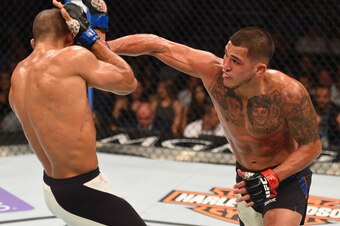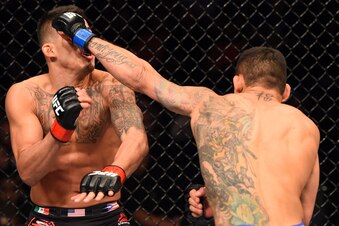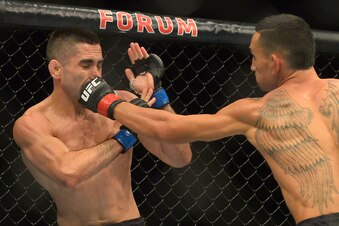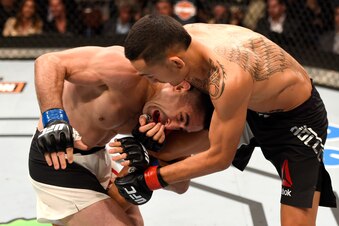While the UFC had to bend over backward to make the featherweight fight between Max Holloway and Anthony Pettis that now headlines UFC 206 an interim title bout, the promotion's machinations do nothing to diminish an outstanding fight.
Pettis, the former lightweight champion, has hit some hard times in the last two years. At the beginning of 2015, he was on top of the world, the UFC's best bet for a new superstar. His first title defense, a submission win over Gilbert Melendez, was fresh in fans' minds. He was even on a Wheaties box.
It didn't take long for everything to fall apart. Rafael Dos Anjos dominated him for all five rounds to take his title in March 2015, and then Eddie Alvarez bullied him against the fence to win a tight decision the following January. Edson Barboza added insult to injury by beating the striker in a three-round match contested entirely on the feet.
Pettis snapped that three-fight losing streak in his first bout at 145 pounds with a win over Charles Oliveira, but whether he'll ever reach the heights he came so tantalizingly close to occupying in 2015 is an open question.
Holloway, by contrast, has flown under the radar for practically his entire career. The Hawaiian debuted in the UFC against Dustin Poirier in February 2012, and toiled away on pay-per-view undercards and out-of-the-way Fight Nights for most of the next several years. All the while, he improved his skills while retaining the action-oriented style that earned him the respect of hardcore fans.
Since dropping a decision to Conor McGregor in August 2013, his second consecutive loss after a robbery against Dennis Bermudez, Holloway has won a staggering nine fights in a row. He dominated veteran striker Cub Swanson on the feet before submitting him and then finished Charles Oliveira. Jeremy Stephens and Ricardo Lamas fell to Holloway by decision to cap off the streak.
This is an outstanding matchup featuring two of the division's best strikers. Let's dig in.
Anthony Pettis
Record: 19-5 (7 KO, 9 SUB, 3 DEC)
Height: 5'10"
Reach: 72"
The former lightweight champion is a marvel of speed and raw athleticism, a bundle of outstanding physical tools married to a charismatic, flashy approach to fighting inside the cage.
Striking is Pettis' wheelhouse. He has built his game around a devastating arsenal of lightning-fast kicks, and while the "Showtime Kick"—the jumping kick off the fence that he used to secure his WEC title win over Benson Henderson in 2010—is an example of his penchant for flash, most of what he throws consists of meat-and-potatoes round kicks, especially the left kick to the body.
Pettis excels at setting up his round kicks from both stances. He likes to flash a jab or combination beforehand, forcing his opponent to raise his guard to expose his ribs. A left or right straight moves his opponent's guard, opening up a round kick to the head. A series of body kicks might force his opponent to drop his guard to cover his ribs, opening up the head kick.
He has a tricky rhythm and does a great job of sticking half-beat pauses in the middle of his combinations to mix up his timing, which makes it difficult for opponents to catch or block his shots. The combination of speed and craft is why so many of Pettis' kicks land so cleanly and to such devastating effect.
While kicks are the obvious strength of his game, Pettis isn't a bad puncher. Basic jab-cross sequences and the occasional right hook from southpaw are his bread and butter, all of them delivered with excellent hand speed if not overwhelming power. He's not a dedicated body puncher, but he mixes it up from time to time.
Counters are the best part of Pettis' punching arsenal. He has outstanding timing and has clearly been well trained to respond to particular triggers when his opponent throws.
That's the good side of Pettis' striking game, but there are also some serious issues that have doomed him in his last several fights.

The first and most important of these is his allergy to pressure. At heart, Pettis is an open-space fighter who needs room and time to operate. He prefers a relatively slow pace and lots of distance between him and his opponent in order to pick and choose his fight-ending shots.
The problem is that Pettis doesn't have the tools to enforce this pace and range in the face of an opponent who wants to take it away.
While he moves well through the space of the cage, constantly circling and looking for angles, his footwork isn't crisp or technical. He doesn't pivot or sidestep with the sharp, efficient acumen of someone like Barboza, McGregor or Aldo, and he doesn't immediately create a new angle after throwing a strike; instead, he takes a step back as if expecting his opponent refuses to be intimidated by his speed and power.
If Pettis' opponent refuses to be intimidated, he can back Pettis into the fence at will. Pettis' go-to response in this situation is to plant his feet and brawl, but with his back to the fence, he can't generate much power, and in any case, Pettis isn't a defensive mastermind in the pocket.

This is why Pettis spent so much time with his back to the fence against Dos Anjos and Alvarez. The takedowns and clinch control Pettis conceded were just symptoms of this basic problem: He should never have been put on the fence so often in the first place.
Pettis isn't a bad defensive wrestler or clinch fighter from a technical perspective. His skills are mostly fine, though he could always stand to spend more time on them. The issue is how often he's put in position to have to use them. If you let an opponent chain takedown after takedown after takedown, eventually they'll succeed, eating up minutes from the clock in the process.
The former lightweight champion isn't much of an offensive wrestler, though he'll occasionally look for a takedown. He could probably stand to invest more in his wrestling game, because Holloway is a slick and dangerous grappler who's always looking for the finish.
Pettis' guard is exceptional. He's constantly attacking and strings together ultra-quick chains of triangles, armbars, omoplatas and sweeps, all of them crisp and technically sound. Getting to the back in transition is another strong suit of his game, and he has a nasty guillotine as well. Strong top-control grapplers can shut him down, but they're still at risk.
Max Holloway
Record: 16-3 (6 KO, 2 SUB, 8 DEC)
Height: 5'11"
Reach: 69"
Like Pettis, Holloway is a striker, but that's where the similarities end. Pace, crisp footwork and slick combinations are the hallmarks of Holloway's game. The Hawaiian drowns his opponents in technically sound offense, punishing them with volume until they quit or the final bell sounds.
Footwork is the straw that stirs the drink of Holloway's approach to striking. He's a master of pivots, sidesteps, turns and understands how to use all these tools in an efficient manner. The mastery of these tools allows Holloway to stick and move against pressuring opponents or to pressure opponents who want to stick and move. It allows him to create dominant angles at will and attack while staying defensively responsible.
As good as he is sticking and moving, though, pressure is the best aspect of Holloway's game. He puts together clean, creative combinations as he moves forward, making use of those angles to confuse his opponent while pushing him back to the fence. When his opponent tries to throw back, Holloway is happy to pull back and counter the counter with another flurry.

Here's one sequence from the Lamas fight that sums up Holloway's approach. He backs Lamas to the fence, and when Lamas tries to create space with a left hook, Holloway jumps on him with a straight left-right hook-straight left-right hook combination. When Lamas tries to escape along the fence, Holloway sticks with him, moves around and under Lamas' tight guard to the head and body.
These kinds of attacking sequences are Holloway's preferred mode, and he creates such dominant angles with his footwork that he often finds himself behind his opponent as he pressures.
Aside from a sharp spinning back kick and the occasional wheel kick, most of Holloway's arsenal consists of basic, crisp boxing, just delivered at an exceptional pace. That sequence above, for example, contained 14 strikes. Repeated over the course of the fight, that's too much offensive output for most opponents to keep up with.
Defense isn't the best aspect of Holloway's game. He's not easy to hit, especially because he does such a great job of managing distance and angles, but when he's in range, he's not an especially crafty user of head movement, parries and blocks.
Range striking is Holloway's bread and butter, and he has the footwork and the distance-management tools to ensure that the fight stays where he wants it. He's hardly helpless elsewhere, though.

The forward-moving combinations that Holloway prefers often mean that he ends up in the clinch, and he excels at delivering a sharp strike or two before breaking off. It's almost impossible to hold onto him if he doesn't want to be there. At this point, Holloway's combination of footwork, angles, distance and outstanding technique makes him one of the best defensive wrestlers in the division and perhaps the sport.
Holloway makes it dangerous to shoot on him. He has a nasty front headlock, from which he likes a smooth guillotine that he often uses to sweep into top position. On the mat, he has a strong passing game and controls well.
Betting Odds
Holloway -210, Pettis +175
Prediction
While Pettis remains one of the most dangerous fighters in the sport and can finish at any time on the feet or on the mat, this is Holloway's fight to lose. The Hawaiian's combination of pressure and offensive output is kryptonite for Pettis, who needs space to operate and wants to pick and choose his shots with care.
Holloway won't let him do that. He'll back Pettis to the fence over and over while putting together creative combinations, and though Pettis will try to back him off, he doesn't have the tools necessary to impose his open-space game. Even if he were more inclined to look for takedowns than he has been historically, Holloway's bulletproof takedown defense should be enough to keep this standing.
There's always a chance that Pettis lands something big, but that seems much less likely than Holloway drowning the former lightweight champion in volume. Holloway overcomes a few scary moments and wins a 49-46 decision.
Odds courtesy of OddsShark; current as of Wednesday.
Patrick Wyman is the Senior MMA Analyst for Bleacher Report and the co-host of the Heavy Hands Podcast, your source for the finer points of face-punching. For the history enthusiasts out there, he also hosts The Fall of Rome Podcast on the end of the Roman Empire. He can be found on Twitter and on Facebook.


















